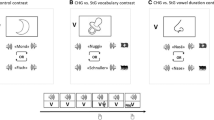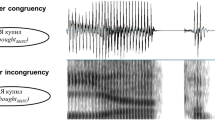Abstract
This article presents a selective overview of studies that have investigated auditory language processing in children and late second-language (L2) learners using online methods such as event-related potentials (ERPs), eye-movement monitoring, or the cross-modal priming paradigm. Two grammatical phenomena are examined in detail, children’s and adults’ processing of German plural inflections (Lück et al. Brain Res 1077:144–152, 2006; Hahne et al. J Cognitive Neurosci 18:121–134, 2006; Clahsen et al. J Child Language 34:601–622, 2007) and language learners’ processing of filler-gap dependencies in English (Felser C, Roberts L Second Language Res 23:9–36, 2007; Roberts et al. J Psycholinguist Res 36:175–188, 2007). The results from these studies reveal clear differences between native and nonnative processing in both domains of grammar, suggesting that nonnative listeners rely less on grammatical parsing routines during processing than either child or adult native listeners. We also argue that factors such as slower processing speed or cognitive resource limitations only provide a partial account of our findings.
Similar content being viewed by others
References
Arnold J.E., Brown-Schmidt S., Trueswell J. (2007) Children’s use of gender and order-of- mention during pronoun comprehension. Language and Cognitive Processes 22: 527–565. doi:10.1080/01690960600845950
Atchley R., Rice M., Betz S., Kwasny K., Sereno J., Jongman A. (2006) A comparison of semantic and syntactic event related potentials generated by children and adults. Brain and Language 99: 236–246
Booth J., MacWhinney B., Harasaki Y. (2000) Developmental differences in visual and auditory processing of complex sentences. Child Development 71: 981–1003. doi:10.1111/1467-8624.00203
Brovetto, C., & Ullman, M. (2001). First vs. second language: A differential reliance on grammatical computations and lexical memory. Poster presented at the 14th Annual CUNY Conference on Human Sentence Processing, University of Pennsylvania.
Chen L., Shu H., Liu Y., Zhao J., Li P. (2007) ERP signatures of subject-verb agreement in L2 learning. Bilingualism: Language and Cognition 10: 161–174. doi:10.1017/S136672890700291X
Clahsen H., Featherston S. (1999) Antecedent-priming at trace positions: Evidence from German scrambling. Journal of Psycholinguistic Research 28: 415–437. doi:10.1023/A:1023293132656
Clahsen H., Felser C. (2006) Grammatical processing in language learners. Applied Psycholinguistics 27: 3–42
Clahsen H., Felser C. (2006) How native-like is non-native language processing?. Trends in Cognitive Sciences 10: 564–570. doi:10.1016/j.tics.2006.10.002
Clahsen H., Hadler M., Weyerts H. (2004) Speeded production of inflected words in children and adults. Journal of Child Language 31: 683–712. doi:10.1017/S0305000904006506
Clahsen H., Lück M., Hahne A. (2007) How children process over-regularizations: Evidence from event-related brain potentials. Journal of Child Language 34: 601–622. doi:10.1017/S0305000907008082
Dallas A., Kaan E. (2008) Second language processing of filler-gap dependencies by late learners. Language and Linguistics Compass 2/3: 372–388. doi:10.1111/j.1749-818X.2008.00056.x
Emmorey K., Bellugi U., Friederici A., Horn P. (1995) Effects of age of acquisition on grammatical sensitivity: Evidence from on-line and off-line tasks. Applied Psycholinguistics 16: 1–23. doi:10.1017/S0142716400006391
Felser C., Marinis T., Clahsen H. (2003) Children’s processing of ambiguous sentences: A study of relative clause attachment. Language Acquisition: A Journal of Developmental Linguistics 11: 127–163. doi:10.1207/s15327817la1103_1
Felser C., Roberts L. (2007) Processing wh-dependencies in a second language: A cross-modal priming study. Second Language Research 23: 9–36. doi:10.1177/0267658307071600
Ferreira F., Bailey K., Ferraro V. (2002) Good enough representations in language comprehension. Current Directions in Psychological Science 11: 11–15. doi:10.1111/1467-8721.00158
Fiebach C., Schlesewsky M., Friederici A. (2002) Separating syntactic memory costs and syntactic integration costs during parsing: The processing of German wh-questions. Journal of Memory and Language 47: 250–272. doi:10.1016/S0749-596X(02)00004-9
Frenck-Mestre C., Pynte J. (1997) Syntactic ambiguity resolution while reading in second and native languages. Quarterly Journal of Experimental Psychology 50A: 119–148. doi:10.1080/027249897392251
Friederici A. (2002) Towards a neural basis of auditory sentence processing. Trends in Cognitive Sciences 6: 78–84. doi:10.1016/S1364-6613(00)01839-8
Friederici, A., & Hahne, A. (2001). Development patterns of brain activity. In J. Weissenborn & B. Höhle (Eds.), Approaches to bootstrapping: Phonological, lexical, syntactic and neurophysiological aspects of early language acquisition (Vol. 2, pp. 231–246). Amsterdam & Philadelphia: John Benjamins.
Gibson E. (2000) The dependency locality theory: A distance-based theory of linguistic complexity. In: Marantz A., Miyashita Y., O’Neil W. (eds) Image, language, brain. MIT Press, Cambridge, MA, pp 95–125
Gibson E., Warren T. (2004) Reading-time evidence for intermediate linguistic structure in long-distance dependencies. Syntax 7: 55–78. doi:10.1111/j.1368-0005.2004.00065.x
Hahne A., Eckstein K., Friederici A. (2004) Brain signatures of syntactic and semantic processes during children’s language development. Journal of Cognitive Neuroscience 16: 1302–1318. doi:10.1162/0898929041920504
Hahne A., Friederici A. (1999) Rule-application during language comprehension in the adult and the child. In: Friederici A., Menzel R. (eds) Learning: Rule extraction and representation. Walter de Gruyter, Berlin & New York, pp 71–88
Hahne A., Müller J., Clahsen H. (2006) Morphological processing in a second language: Behavioral and event-related brain potential evidence for storage and decomposition. Journal of Cognitive Neuroscience 18: 121–134. doi:10.1162/089892906775250067
Hestvik, A., Schwartz, R., Tornyova, L., & Datta, H. (2005, Spetember). Picture-naming shows children reactivate antecedents at trace positions. Poster presented at GASLA, Siena, Italy.
Jiang N. (2004) Morphological insensitivity in second language processing. Applied Psycholinguistics 25: 603–634. doi:10.1017/S0142716404001298
Jiang N. (2007) Selective integration of linguistic knowledge in adult second language learning. Language Learning 57: 1–33. doi:10.1111/j.1467-9922.2007.00397.x
Kidd E., Bavin E. (2007) Lexical and referential influences on on-line spoken language comprehension: A comparison of adults and primary-school-age children. First Language 27: 29–52. doi:10.1177/0142723707067437
Klein W. (1986) Second language acquisition. Cambridge University Press, Cambridge
Krott A., Baayen H., Hagoort P. (2006) The nature of anterior negativities caused by misapplications of morphological rules. Journal of Cognitive Neuroscience 18: 1616–1630. doi:10.1162/jocn.2006.18.10.1616
Lee M.-W. (2004) Another look at the role of empty categories in sentence processing (and grammar). Journal of Psycholinguistic Research 33: 51–73. doi:10.1023/B:JOPR.0000010514.50468.30
Lew-Williams C., Fernald A. (2007) Young children learning Spanish make rapid use of grammatical gender in spoken word recognition. Psychological Science 18: 193–198. doi:10.1111/j.1467-9280.2007.01871.x
Lew-Williams, C., & Fernald, A. (2007b). How first and second language learners use predictive cues in online sentence interpretation in Spanish and English. In H. Caunt-Nulton, S. Kulatilake, & I. Woo (Eds.), BUCLD 31: Proceedings of the 31st annual Boston University conference on language development (pp. 382–393). Somerville, MA: Cascadilla Press.
Love T. (2007) The processing of non-canonically ordered constituents in long distance dependencies by pre-school children: A real-time investigation. Journal of Psycholinguistic Research 36: 191–206. doi:10.1007/s10936-006-9040-9
Love T., Maas E., Swinney D. (2003) The influence of language exposure on lexical and syntactic language processing. Experimental Psychology 50: 204–216. doi:10.1026//1617-3169.50.3.204
Lück M., Hahne A., Clahsen H. (2006) Brain potentials to morphologically complex words during listening. Brain Research 1077: 144–152. doi:10.1016/j.brainres.2006.01.030
Marinis T., Roberts L., Felser C., Clahsen H. (2005) Gaps in second language sentence processing. Studies in Second Language Acquisition 27: 53–78. doi:10.1017/S0272263105050035
McDonald J. (2000) Grammaticality judgments in a second language: Influences of age of acquisition and native language. Applied Psycholinguistics 21: 395–423. doi:10.1017/S0142716400003064
McDonald J. (2006) Beyond the critical period: Processing-based explanations for poor grammaticality judgment performance by late second language learners. Journal of Memory and Language 55: 381–401. doi:10.1016/j.jml.2006.06.006
McKee C., Nicol J., McDaniel D. (1993) Children’s application of binding during sentence processing. Language and Cognitive Processes 8: 265–290. doi:10.1080/01690969308406956
Meisel J. (1991) Principles of universal grammar and strategies of language use. In: On some similarities, dioerences between first, secondlanguageacquisition.In Eubank L. (eds) Point–counterpoint. Universal grammar in the second language. John Benjamins, Amsterdam & Philadelphia, pp 231–276
Mueller J. (2005) Electrophysiological correlates of second language processing. Second Language Research 21: 152–174. doi:10.1191/0267658305sr256oa
Nakano Y., Felser C., Clahsen H. (2002) Antecedent priming at trace positions in Japanese long-distance scrambling. Journal of Psycholinguistic Research 31: 531–571. doi:10.1023/A:1021260920232
Nation K., Marshall C., Altmann G. (2003) Investigating individual differences in children’s real-time sentence comprehension using language-mediated eye movements. Journal of Experimental Child Psychology 86: 314–329. doi:10.1016/j.jecp.2003.09.001
Nicol J. (1993) Reconsidering reactivation. In: Altmann G., Shillcock R. (eds) Cognitive models of speech processing: The second Sperlonga meeting. Lawrence Erlbaum Associates, Hove, pp 321–350
Oberecker R., Friedrich M., Friederici A. (2005) Neural correlates of syntactic processing in two-year-olds. Journal of Cognitive Neuroscience 17: 1667–1678. doi:10.1162/089892905774597236
Papadopoulou D. (2005) Reading-time studies of second language ambiguity resolution. Second Language Research 21: 98–120. doi:10.1191/0267658305sr254oa
Parodi T., Schwartz B., Clahsen H. (2004) On the L2 acquisition of the morphosyntax of German nominals. Linguistics 42: 669–705. doi:10.1515/ling.2004.022
Pinker S. (1999) Words and rules. Basic Books, New York
Prasada, S., Pinker, S., & Snyder, W. (1990). Some evidence that irregular forms are retrieved from memory but regular forms are rule-generated. Paper presented at the 31st Annual Meeting of the Psychonomic Society, New Orleans, LA.
Roberts L., Gullberg M., Indefrey P. (2008) Online pronoun resolution in L2 discourse: L1 influence and general learner effects. Studies in Second Language Acquisition 30: 333–357. doi:10.1017/S0272263108080480
Roberts L., Marinis T., Felser C., Clahsen H. (2007) Antecedent priming at trace positions in children’s sentence processing. Journal of Psycholinguistic Research 36: 175–188. doi:10.1007/s10936-006-9038-3
Sanford A., Sturt P. (2002) Depth of processing in language comprehension: Not noticing the evidence. Trends in Cognitive Sciences 6: 382–386. doi:10.1016/S1364-6613(02)01958-7
Sato M., Felser C. (2006) Sensitivity to semantic and morphosyntactic violations in L2 sentence processing: Evidence from speeded grammaticality judgements. Essex Research Reports in Linguistics 51: 1–39
Sekerina I., Fernández E., Clahsen H. (Eds.). (2008) Developmental psycholinguistics: On-line methods in children’s language processing. John Benjamins, Amsterdam & Philadelphia
Sekerina I., Stromswold K., Hestvik A. (2004) How adults and children process referentially ambiguous pronouns. Journal of Child Language 31: 123–152. doi:10.1017/S0305000903005890
Silva, R., & Clahsen, H. (2008). Morphologically complex words in L1 and L2 processing: Evidence from masked priming experiments in English. Bilingualism: Language and Cognition, 11(2) (to appear). doi:10.1017/S1366728908003404.
Silva-Pereyra J., Klarman L., Lin J., Kuhl P. (2005) Sentence processing in 30-month old children: An ERP study. Neuroreport 16: 645–648. doi:10.1097/00001756-200504250-00026
Snedeker J., Trueswell J. (2004) The developing constraints on parsing decisions: The role of lexical-biases and referential scenes in child and adult sentence processing. Cognitive Psychology 49: 238–299. doi:10.1016/j.cogpsych.2004.03.001
Song H., Fisher C. (2007) Discourse prominence effects on 2.5-year-old children’s interpretation of pronouns. Lingua 117: 1959–1987. doi:10.1016/j.lingua.2006.11.011
Swinney D., Prather P. (1989) On the comprehension of lexical ambiguity by young children: Investigations into the development of modularity. In: Gorfein D. (eds) Resolving semantic ambiguity. Springer, Berlin
Townsend D., Bever T. (2001) Sentence comprehension: The integration of habits and rules. MIT Press, Cambridge, MA
Trueswell J., Sekerina I., Hill N., Logrip M. (1999) The kindergarden-path effect: Studying on-line sentence processing in children. Cognition 73: 89–134. doi:10.1016/S0010-0277(99)00032-3
Ullman M. (2005) A cognitive perspective on second language acquisition: The declarative/procedural model. In: Sanz C. (eds) Mind and context in adult second language acquisition: Methods, theory, and practice. Georgetown University Press, Washington, DC, pp 141–178
Williams J. (2006) Incremental interpretation in second language sentence processing. Bilingualism: Language and Cognition 9: 71–88. doi:10.1017/S1366728905002385
Williams J., Möbius P., Kim C. (2001) Native and non-native processing of English wh-questions: Parsing strategies and plausibility constraints. Applied Psycholinguistics 22: 509–540. doi:10.1017/S0142716401004027
Author information
Authors and Affiliations
Corresponding author
Rights and permissions
About this article
Cite this article
Felser, C., Clahsen, H. Grammatical Processing of Spoken Language in Child and Adult Language Learners. J Psycholinguist Res 38, 305–319 (2009). https://doi.org/10.1007/s10936-009-9104-8
Received:
Accepted:
Published:
Issue Date:
DOI: https://doi.org/10.1007/s10936-009-9104-8




